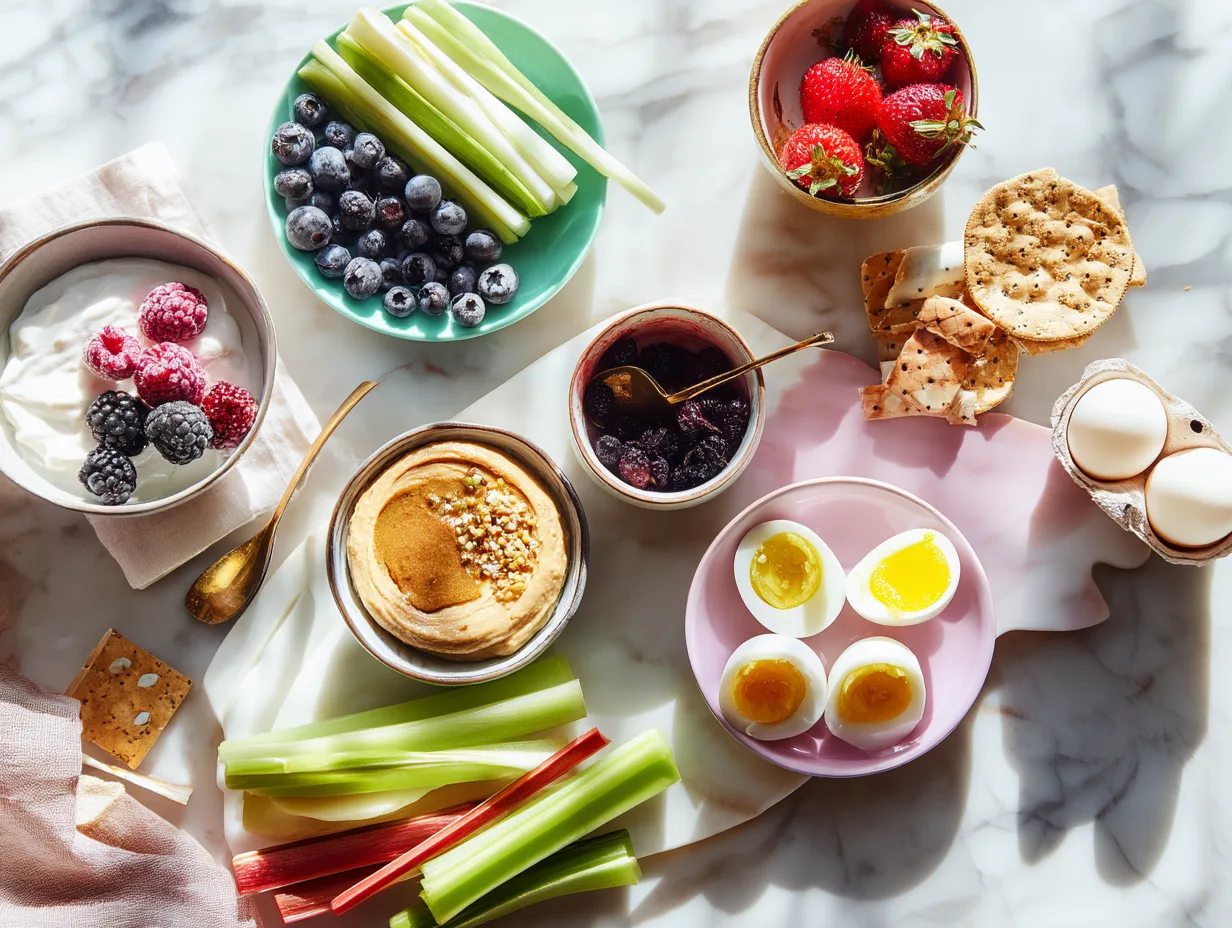Snacking tends to get a bad rap, especially when you’re managing diabetes. The reality is that smart snacking can be a useful tool for stabilizing blood sugar, maintaining steady energy, and curbing excessive hunger between meals. The key lies in choosing Low-Glycemic Snacks That Actually Taste Good, ensuring that you stay on track with your glucose goals without sacrificing flavor. This guide explores why low-glycemic snacks are beneficial, highlights the best ingredients to look for, and provides easy ideas that satisfy both your palate and your health needs.
Why Low-Glycemic Snacks Matter
The glycemic index (GI) ranks carbohydrate-containing foods by how much they raise your blood sugar levels. Foods with a low GI (55 or less) cause a slower, more gradual increase in blood sugar. For individuals with diabetes, these snacks can help maintain a more consistent glucose curve, preventing the spikes and crashes that lead to energy slumps and potential complications.
- Steady Blood Sugar: Low-GI snacks help avoid sudden surges in blood sugar, making insulin regulation more manageable.
- Reduced Cravings: By stabilizing energy levels, these snacks help curb the desire to overeat or reach for sugary treats.
- Long-Lasting Satiety: High-fiber, low-glycemic foods keep you feeling full, helping control overall caloric intake.
For more insights on balancing your carb intake, check out our post on Meal Planning for Diabetes, where we discuss strategies for structuring daily meals to maintain stable blood sugar.
Essential Components of Low-Glycemic Snacks That Actually Taste Good
When scouting for Low-Glycemic Snacks That Actually Taste Good, aim for a balance of nutrients that includes slow-digesting carbohydrates, protein, and healthy fats. This combination not only manages blood sugar but also ensures a more satisfying experience.
Fiber-Rich Carbohydrates
Fiber is your ally in any diabetic-friendly plan. It slows digestion and softens glucose impact:
- Whole Grains: Choose crackers or bread made from 100% whole wheat or other whole grains.
- Fruits: Berries, apples with skin, and pears are naturally sweet yet low on the glycemic scale.
- Legumes: Chickpeas, lentils, and beans work well in dips or salads.
Quality Protein
Protein moderates sugar absorption and helps you feel satisfied:
- Greek Yogurt: Opt for unsweetened varieties; top with berries or nuts for added texture.
- Cheese: Go for low-fat cheese sticks or cottage cheese paired with whole-grain crackers.
- Lean Meats: Turkey slices wrapped around vegetables provide a tasty, protein-packed snack.
Healthy Fats
Adding healthy fats can improve insulin sensitivity and prolong satiety:
- Avocado: Spread on whole-grain crackers or use as a dip.
- Nuts and Seeds: Almonds, walnuts, chia seeds, and flaxseeds.
- Nut Butters: Peanut, almond, and cashew butter on apple slices or celery sticks.
For tips on portion control and reading labels, refer to our post on Decoding Food Labels, which covers how to identify hidden sugars and understand nutrient claims.
Low-Glycemic Snack Ideas
Finding low-glycemic snacks doesn’t mean resorting to bland or boring. Here are creative ideas that not only promote blood sugar stability but also offer satisfying flavor.
1. Veggie Sticks with Hummus
- Why It Works: Crisp vegetables like bell peppers, cucumbers, and carrots supply fiber and antioxidants, while hummus delivers protein and healthy fats from chickpeas and tahini.
- Flavor Tips: Sprinkle paprika or drizzle olive oil on the hummus for an extra kick.
2. Apple Slices with Nut Butter
- Why It Works: Apples have soluble fiber (pectin), which helps stabilize blood sugar, and nut butter adds protein and fats.
- Flavor Tips: Use cinnamon for added sweetness without sugar.
3. Greek Yogurt Parfait
- Why It Works: Low in carbs and high in protein, Greek yogurt is easy on blood sugar. Toppings like fresh berries, chia seeds, or a sprinkle of chopped nuts deliver extra fiber.
- Flavor Tips: A light drizzle of honey can be acceptable in small amounts, but monitor portion sizes to avoid sugar spikes.
4. Whole-Grain Crackers with Cottage Cheese
- Why It Works: Cottage cheese boasts a great protein-to-carb ratio, and whole-grain crackers slow carbohydrate absorption.
- Flavor Tips: Top with sliced tomatoes or cucumbers for extra crunch and vitamins.
5. Roasted Chickpeas
- Why It Works: Packed with fiber and protein, chickpeas help moderate blood glucose.
- Flavor Tips: Season with chili powder, garlic, or curry for a savory punch. Bake until crispy.
6. Edamame
- Why It Works: High in protein and fiber, edamame keeps you satisfied and supports stable blood sugar.
- Flavor Tips: Steam lightly, then add a pinch of salt or low-sodium soy sauce.
7. Tuna Salad Lettuce Wraps
- Why It Works: Protein from tuna, minimal carbs from lettuce. Add diced celery or onions for texture.
- Flavor Tips: Mix with a small amount of Greek yogurt and mustard for a tangy dressing.
8. Homemade Trail Mix
- Why It Works: A mix of nuts and seeds provides protein, healthy fats, and fiber. Include a modest portion of dried fruit (unsweetened) if desired.
- Flavor Tips: Add unsweetened coconut flakes or a few dark chocolate chips for variety.
For more inspiration on how to transform common ingredients into low-glycemic meals, check out our Hearty Lentil Soup with a Twist post, which demonstrates how simple swaps can significantly reduce a dish’s impact on blood sugar.
How to Build Low-Glycemic Snacks That Actually Taste Good on the Go
Busy lifestyles shouldn’t stand in the way of healthy snacking. Keep these tips in mind:
- Pre-Portion: Use small containers or resealable bags. This ensures you don’t overeat and can quickly grab a healthy snack.
- Pair Carbs with Protein: Combining a carb source with protein (e.g., an apple with string cheese) prevents glucose spikes.
- Focus on Whole, Minimally Processed Foods: Seek out natural options rather than highly processed products.
- Check the Label: Aim for snacks with 5 or more grams of fiber, little to no added sugar, and some protein.
If you need further guidance on balancing macros in snacks, refer to our article on How to Identify Hidden Sugars in Food. It teaches you how to spot sneaky ingredients that could derail your low-glycemic goals.
The Role of the Air Fryer in Diabetes-Friendly Snacking
An air fryer can be a lifesaver if you want crispy, satisfying snacks without excessive oil—ideal for people watching their fat and carb intake. By circulating hot air, these appliances create a crunchy exterior on foods like vegetables, chickpeas, or even lean protein bites.
- Crispy Veggie Fries: Air-fry zucchini, carrot, or green bean “fries” with a spritz of cooking spray. They satisfy crunch cravings and remain low in glycemic load.
- Seasoned Nuts: Lightly coat almonds or cashews in egg whites and seasonings, then air-fry for a nutritious crunchy treat.
For more detailed air fryer recipes perfectly suited to a diabetic meal plan, the Diabetic Air Fryer Cookbook offers valuable inspiration and step-by-step guidance.
Common Pitfalls and How to Avoid Them
- Overdoing Portion Size: Even a low-glycemic food can spike blood sugar if eaten in excess. Use measuring cups or a food scale for more accurate portions.
- Relying on Packaged “Diet Foods”: Many labeled as “diabetic-friendly” or “low-glycemic” may still contain added sugars or unwanted fillers. Always check the nutrition label.
- Not Enough Protein or Fiber: A snack that’s primarily carbs—even if low-glycemic—might not keep you satisfied. Include adequate protein or fiber to feel fuller longer.
If you suspect you’re consuming hidden sugars or additives, see our guide on Decoding Food Labels. It breaks down how to scrutinize nutritional information and ingredient lists.
Planning Ahead for Success
Staying consistent with Low-Glycemic Snacks That Actually Taste Good often depends on planning and availability. Try these strategies:
- Schedule Weekly Prep: Set aside time to wash, chop, and portion fruits, veggies, and proteins. Store them in clear containers.
- Travel-Friendly Kits: For commuting or running errands, pack small, insulated lunch bags with items like Greek yogurt cups, cheese sticks, or pre-cut veggies.
- Diversify Your Options: Keep a list of go-to snack ideas on your phone or fridge to avoid boredom and impulsive choices.
Additionally, staying hydrated can keep cravings at bay. Thirst sometimes masquerades as hunger, so remember to drink water regularly throughout the day.
Sample Low-Glycemic Snack Plan
Below is an example of how you might structure your snacks across a single day:
- Mid-Morning: Greek yogurt topped with raspberries and a sprinkle of chia seeds.
- Afternoon: Whole-grain crackers paired with cottage cheese and cucumber slices.
- Evening: Air-fried zucchini “chips” dusted with parmesan cheese.
Each snack combines fiber, protein, or healthy fats to maintain energy levels and stabilize blood sugar.
Putting It All Together
Selecting Low-Glycemic Snacks That Actually Taste Good doesn’t have to be a struggle. By focusing on foods rich in fiber, protein, and healthy fats—and leveraging tools like air fryers—you can craft snack options that deliver both flavor and nutrition. Variety is key, so rotate your snacks to stay excited about healthier choices. Pair these strategies with other pillars of diabetes management—such as consistent exercise, portion control, and stress reduction—to form a holistic approach to well-being.
For additional information about diabetes care and healthy snacking, visit the American Diabetes Association to explore their extensive resources.
Remember, the ultimate goal is to enjoy food while maintaining stable glucose levels. With careful selection and some creativity, you can snack confidently and keep your diabetes management on track.


Leave a Reply